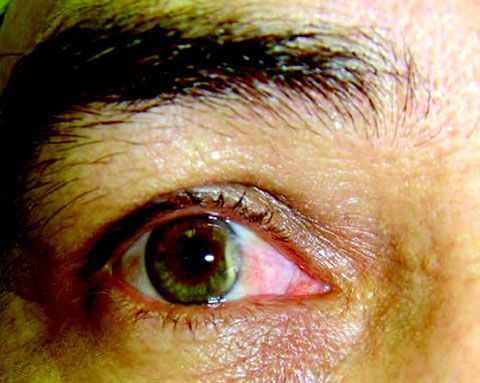- Clinical Technology
- Adult Immunization
- Hepatology
- Pediatric Immunization
- Screening
- Psychiatry
- Allergy
- Women's Health
- Cardiology
- Pediatrics
- Dermatology
- Endocrinology
- Pain Management
- Gastroenterology
- Infectious Disease
- Obesity Medicine
- Rheumatology
- Nephrology
- Neurology
- Pulmonology
Middle-Aged Man With Wedge-Shaped Growths in Both Eyes
A 45-year-old man of Hispanic ancestry presents for evaluation of what he describes as a "growth in both eyes." This growth has been present for some time; however, it has recently become more prominent. The patient has had mild redness and irritation in both eyes, but he denies any change in vision.

HISTORY
A 45-year-old man of Hispanic ancestry presents for evaluation of what he describes as a "growth in both eyes." This growth has been present for some time; however, it has recently become more prominent. The patient has had mild redness and irritation in both eyes, but he denies any change in vision.
PHYSICAL EXAMINATION
Both pupils are round, equal, and reactive to light and accommodation.
No discharge is evident in either eye. However, the patient has well-defined wedge-shaped growths on the medial aspects of both eyes, which extend onto the corneas. Examination of the upper and lower eyelids reveals no abnormal findings.
WHAT'S YOUR DIAGNOSIS?
ANSWER: BILATERAL PTERYGIA
PTERYGIUM: A BRIEF OVERVIEW
A pterygium appears as a well-defined triangular growth from the nasal conjunctiva that extends horizontally onto the cornea. The differential diagnosis is very limited given the unique appearance of the growth.
A pterygium does not usually interfere with vision, although in very advanced cases, it can extend close to the pupil and interfere with the visual axis. When a pterygium extends more than a few millimeters onto the cornea, irregular astigmatism can result.1 In most cases, pterygia are of concern to patients and clinicians because of the abnormal appearance and the irritation and redness that are often associated with these growths.
RISK FACTORS FOR PTERYGIUM
Little is know about the pathogenesis of pterygium, although several theories have been suggested. The Barbados Eye Study found higher rates of pterygium among persons of African ancestry as well as those who worked outdoors.2 The incidence was lower among persons who worked outdoors but wore sunglasses, which suggests that sunlight exposure-more specifically, UV light exposure-is associated with this disorder.2,3 Other studies have suggested that the use of prescription sunglasses and smoking are associated with lower risk, while white race, male sex, and increasing age are associated with elevated risk.2,4,5
TREATMENT
Topical ophthalmological lubricants can be used to treat redness and irritation. Surgical removal of a pterygium is indicated if it affects or threatens to affect the visual axis or if eye movements are restricted. Astigmatism induced by a pterygium is also an indication for surgical excision. Nonsurgical techniques have no effect on pterygium progression or growth.
There has been some argument about the usefulness of removing pterygia that result in significant astigmatism, because it is unclear from the literature to what degree the astigmatism will revert after successful removal. However, removal of the pterygium would appear to be a sensible first step in attempting to correct high degrees of astigmatism that may be caused by the pterygium itself.
Because the recurrence rate following surgical excision is 30% to 50%, removal of pterygia for cosmetic reasons or removal of growths that are too small to cause visual changes is not recommended.6 Adjunctive therapies that reduce recurrence after excision include a sliding conjunctival flap over bare-sclera excision, rotational conjunctival autografting, intraoperative or postoperative application of mitomycin C, beta irradiation, and amniotic membrane transplant. Conjunctival autografting and application of mitomycin C are currently the most commonly used methods.7 Recent studies of surgical treatment using limbal stem cells and conjunctival autograft transplant have demonstrated much higher success rates and lower incidences of recurrence.8
PREVENTION
Given the high rate of recurrence of pterygia, education about prevention of primary formation of these growths is important. Because the major modifiable risk factor appears to be exposure of the eyes to UV light/sunlight, proper eye protection seems to be the most practical advice for patients at risk.
References:
REFERENCES:
1. Lin A, Stern G. Correlation between pterygium size and induced corneal astigmatism. Cornea. 1998;17:28-30.
2. Luthra R, Nemesure BB, Wu SY; Barbados Eye Studies Group. Frequency and risk factors for pterygium in the Barbados Eye Study. Arch Ophthalmol. 2001;119:1827-1832.
3. Moran DJ, Hollows FC. Pterygium and ultraviolet radiation: a positive correlation. Br J Ophthalmol. 1984;68:343-346.
4. Nemesure B, Wu SY, Hennis A, Leske MC; Barbados Eye Studies Group. Nine-year incidence and risk factors for pterygium in the Barbados Eye Studies. Ophthalmology. 2008;115:2153-2158.
5. Wong TY, Foster PJ, Johnson GJ, et al. The prevalence and risk factors for pterygium in an adult Chinese population in Singapore: the Tanjong Pagar survey. Am J Ophthalmol. 2001;131:176-183.
6. Sebban A, Hirst LW. Pterygium recurrence rate at the Princess Alexandra Hospital. Aust N Z J Ophthalmol. 1991;19:203-206.
7. Ang LP, Chua JL, Tan DT. Current concepts and techniques in pterygium treatment. Curr Opin Ophthalmol. 2007;18:308-313.
8. Mahdy S, Bhatia J. Treatment of primary pterygium: role of limbal stem cells and conjunctival autograft transplantation. Eur J Ophthalmol. 2009;19:729-732.
